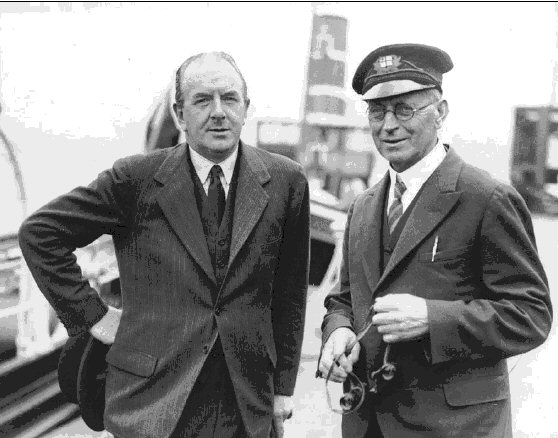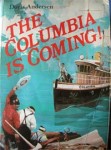I have mentioned a few of these boats before on this site – the Thomas Crosby V (here and here), the Columbia III, and the William H. Pierce. This article should finish the series once and for all. I never knew there were so many church mission boats on the British Columbia (BC) coast.
In the early 1900s lighthouses were very isolated. Maybe a Coast Guard ship about every six (6) months, but to the keepers, and many other isolated residents of the BC coast the mission boats were their only contact with civilization. Here is a list of others I have found, which also includes a short mention of the ones mentioned above (listed in alphabetical order).
John Antle (Columbia Coast Mission) (1904)
The pioneer mission hospital of St. Mary’s, Pender Harbour, where Anglican ships had brought their patients, still standing but reincarnated these days as the Sundowner Inn, was 75 in 2004. It was built by the Columbia Coast Mission, which started life 100 years ago when Rev. John Antle and his nine-year-old son, Victor, left Vancouver in their open, five-metre boat on an 800-kilometre journey to Alert Bay and back.
The handsome wood building, erected as a 14-bed hospital in 1929, was converted to a hotel and restaurant after a 50-bed St. Mary’s opened in Sechelt in 1964.
John Antle and his successors brought medical and pastoral care to the rough-and-tumble settlers of the southern B.C. coast, serving an area from Sechelt to Kingcome Inlet, including the east shore of Vancouver Island and up Bute and Jervis inlets. They were known to every logger, fisher, homesteader, and First Nations community in the region. They attended christenings, marriages, and burials, established hospitals, preached at church services, pulled teeth, delivered mail, and provided fellowship and advice. They also ran a well-known, well-loved fleet of Anglican mission boats, including numerous vessels named Columbia and John Antle.
For sixty-four years, from 1905 to 1969, people living in the remote settlements, logging camps, inlets and lonely bays of British Columbia’s coast grew to depend on the ships and crews of the Columbia Coast Mission, founded in 1904 by the Rev John Antle.
For over 50 years of its seagoing life, the Columbia Coast Mission which John Antle founded, eventually ran some 20 boats and one aircraft, offering pastoral, medical, dental and social care to the isolated and needy. All this took place at a time when the province offered neither health care nor medical insurance, neither workers’ compensation, nor social welfare. The various ships named Columbia and John Antle still capture the imagination of settlers and seafarers alike.
Columbia I (Anglican) (1905) – In 1905, the mission ship Columbia was built and launched in Vancouver. The ship was a dispensary, a consultation room, an emergency ward or an ambulance, as occasion demanded. It was also a travelling library and a chapel. A doctor was hired; he was also a mechanical engineer. The Reverend John Antle was trained to be an anaesthetist; he combined this job with his other work as chaplain, skipper of the Columbia, first-aid expert, nurse, sometimes cook , editor of the monthly magazine and superintendent of all activities of the Mission.
Columbia II (Anglican) (1910) – In 1910 Columbia II was launched in New Westminster. The new 106-ton gasoline mission vessel Columbia, 86.6 x 16.4, at New Westminster for the Columbia Coast Mission service of the Anglican Church. (Gordon Newell, Marine events of 1910, H.W. McCurdy Marine History of the Pacific Northwest, p. 174) The new vessel had all the necessary facilities for giving medical and surgical aid, and in addition had a radio-telephone which facilitated the emergency communications. Initially the Columbia Coast Mission had a phenomenally rapid growth. As the years passed, the Mission continued to expand, but at a slower pace. The activities of the Mission were numerous: it undertook annual medical examinations of school children, conducted outpost clinics, gave pre-and post-natal care, and established well baby clinics for Indian mothers.
In the 1930s the Columbia II was sold and re-named the Wayward Lady and is reported to have been used a s a rum runner.
The Columbia Coast Mission, though it belongs equally to New Westminster and to Columbia. The Rev. John Antle in his Mission Boat Columbia
Number 2 comes into touch with 4,000 or 5,000 loggers in some 7 5 camps in the Gulf of Georgia. It is a floating library, carrying books, magazines and newspapers to thousands of isolated men. It is a floating ambulance and hospital, treating slight cases of illness or accident in its own cots and by means of its own surgeon, and conveying more serious cases to well-equipped hospitals at Van Anda, in the South, at Rock Bay, in the centre, and at Alert Bay in North, while its main object is to reach and benefit the souls and lives of the men through the spiritual ministrations of the Church.
Columbia III (Anglican) (1956) – The Columbia III was designed in 1955 by renowned naval architect Robert Allan of Vancouver B.C. She was built the following year at Star Shipyards in New Westminster B.C. and still has her original Gardner diesel engine. She serviced the coast as a hospital ship, answering emergency calls until 1968, when it became evident that float planes met the needs of the logging camps and coastal villages much faster than a ship traveling at 8 knots. Also, the coastal population was dwindling as people left the hardships of isolated living and moved to urban areas. The Columbia III was restored to its present immaculate condition in 1990 by Bill McKechnie of Victoria B.C. and since then she’s been used as a charter boat, especially as a kayaking “mothership”. Today still, wherever we go, she is welcomed and recognized, and many stop to reminisce, relive and share their personal experiences aboard the Columbia III.
Fredna (Anglican) –
Glad Tidings (Methodist) –
John Antle V (now Chelsea II) – The boat is now owned and operated by Nils Lovemark.
 Johnston and Rev. John Antle on board M.V. John Antle before the 84 foot BC Columbia
Johnston and Rev. John Antle on board M.V. John Antle before the 84 foot BC Columbia
Coast Mission boat embarked for the West Coast from its berth on the Thames, England,
1933.
Laverock (Anglican) (1904) – “North by West in the Sunlight.” Thus began the log of John Antle, a maverick Newfoundland clergyman and deep-water sailor. It was late afternoon on 1 June 1904, and Antle had just set off with his 10-year-old son to explore the BC coast in his 16-foot homemade boat. The sloop-rigged Laverock was powered by hand-cut canvas sails and a quarter-horsepower Bull Pup outboard engine. Reflecting on the successes of the Grenfell Mission in Newfoundland and Labrador, he wanted to discover just how a faith-based medical mission could serve coastal settlers. His journey to the hand-loggers, fishermen and settlers took him on a colourful adventure—and to the founding of the Columbia Coast Mission.
Messenger III (Shantyman’s Missionary Society) – Owned by the Scott family from Victoria. This vessel was operated from 1946 to 1968 by the Shantyman’s Missionary Society, a nonsectarian group on the west coast of Vancouver Island.
Northern Cross (Prince Rupert Coast Mission – Anglican) – The Northern Cross, built in 1929, was put to good use by the Prince Rupert Coast Mission, another Anglican ministry, until the early 1950s, cruising to canneries, mines, and Tsimshian villages from Anyox to Butedale.
Princess Louise Junior – The propeller Princess Louise, Jr., was purchased in 1881 by Mr. Duncan and taken to the Metlakatlah mission in Alaska. E.W. Wright, Marine business of 1881, Lewis & Dryden’s Marine History of the Pacific Northwest. (written in 1895)., p. 298.
Princeton – The 68 -foot Presbyterian mission boat Princeton Capt. John Falconer, ran aground in Lynn Canal, Alaska on October 12 and was abandoned as a total loss. Gordon Newell, Maritime Events of 1939, H.W. McCurdy Marine History of the Pacific Northwest, p. 475. – Reference
Rendevous (Anglican) – The 10-metre Tari Jacque was originally the Rendezvous , built for the Columbia Coast Mission in 1924 by the Hoffar shipyards in Vancouver. It was a faithful mission servant for 31 years, working mainly out of Quathiaski Cove on Quadra Island under Rev. Alan Greene, and Whaletown on Cortes Island under Rev. Rollo Boas. Victoria’s Ed Tooker has owned the Rendezvous since 1955. – Reference
Sea Queen (Roman Catholic) – One remembers the Roman Catholic Sea Queen and Star of the Sea operating briefly out of Friendly Cove
Star of the Sea (Roman Catholic) – One remembers the Roman Catholic Sea Queen and Star of the Sea operating briefly out of Friendly Cove
Thomas Crosby IV (United Church) – Now the Argonaut II from Seattle, with its spacious covered back deck and tapered canoe stern. Twenty-two metres in length, the Argonaut II was built as the Greta M in 1922 for the Powell River Company, a floating palace for entertaining corporate guests. From 1937 to 1966 it served on B.C.’s north coast as the Thomas Crosby IV , a United Church mission boat.
Udal – The Udal, a twenty ton sloop – rigged mission launch of 40 horsepower, 56 x 12 feet, was built at Vancouver for the Methodist mission service, replacing the Glad Tidings. Gordon Newell, Maritime events of 1909, H.W. McCurdy Marine History of the Pacific Northwest, p. 160. Missionary ship wrecked in 1909, CUD, p. 369. – Reference
Veracity (Anglican) –
Vine – Shipwrecks in Alaskan waters continued to be numerous, including the mission schooner Vine of San Francisco, which was supplying various northern missions, driven ashore in Kotzebue Sound September 20 after losing both anchors. The crew reached St. Lawrence Island by boat, where they were picked up by the trading schooner T P. Abler.Gordon Newell, Maritime Events of 1907, H.W. McCurdy Marine History of the Pacific Northwest., p. 137.. – Reference
William H. Pierce –
************************************
Books on the Mission Boats
 God’s little ships: a history of the Columbia Coast Mission by Michael Hadley
God’s little ships: a history of the Columbia Coast Mission by Michael Hadley
Harbour Pub., 1995 – 308 pages
The men and women of the Columbia Coast Mission ships, legendary figures in the history of the BC coast, are brought vividly to life in this readable, well-researched volume. From 1904 to the mid-1970s, the mission sent out ships in all kinds of weather, delivering medical care and non-sectarian spiritual support to logging camps, Native villages and white settlements in 20,000 square miles of rugged coastline. John Antle, who founded the mission, was a devout and practical Christian who measured his success in services to BC’s outposts, rather than material wealth or number of converts. Immortalized in Margaret Craven’s I Heard the Owl Call My Name, and in the hearts and memories of families all over the coast, the mission was a glad, bold organization that could be as rough-cut and unconventional as the individuals it served. – Google Books
 The Columbia is Coming by Doris Anderson
The Columbia is Coming by Doris Anderson
The story of the Columbia Coast Mission from 1905 to 1969 who brought medical supplies and religion to the British Columbia coastal communities.
Gray’s Publishing, Sidney, BC 1982
ISBN 10: 0888260946 / ISBN 13: 9780888260949
*************************************
http://www.mothershipadventures.com/articles/weeda.htm
Wooden Boats of BC http://www.halfmoon.ca/boats/
Magellan – Ships Encyclopedia – http://www.cimorelli.com/cgi-bin/magellanscripts/
http://books.google.at/books?id=Giiz_m_V92kC&pg=PA54&lpg=PA54&dq=%2B%22MISSION+BOAT%22+%2B%22JOHN+ANTLE%22&source=bl&ots=V6kEAXft4P&sig=glnQSJhYENvWF6mRlsKOBOyW2RI&hl=en&sa=X&ei=jKucUPnGGcvOrQfalIGYBA&ved=0CDMQ6AEwBTgK#v=onepage&q&f=false
http://www.ebooksread.com/authors-eng/louis-norman-tucker/from-sea-to-sea–the-dominion-ala/page-7-from-sea-to-sea–the-dominion-ala.shtml
http://memorybc.ca/antle-john;isaar
http://www.mothershipadventures.com/columbia_III-mothership/columbia_III-mothership_adventures.htm
http://mmbc.bc.ca/wp-content/uploads/2012-Fall-Waterlines-Final.pdf